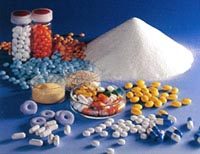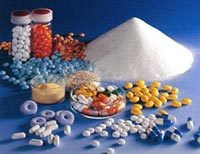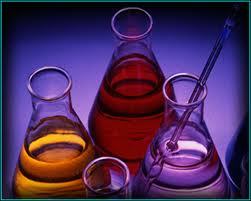Quinine Sulphate
Product Details:
- Storage Room Temperature
- Molecular Weight 746.9 g/mol GSM (gm/2)
- Molecular Formula C40H50N4O8S
- Medicine Name Quinine Sulphate
- Type Pharmaceutical Intermediates
- Grade Medicine Grade
- Purity(%) 98%
- Click to View more
Quinine Sulphate Price And Quantity
- 25 Kilograms
- 1500.0 INR/Kilograms
Quinine Sulphate Product Specifications
- C40H50N4O8S
- 746.9 g/mol GSM (gm/2)
- Room Temperature
- 98%
- Quinine Sulphate
- Medicine Grade
- Pharmaceutical Intermediates
Quinine Sulphate Trade Information
- Cash Advance (CA), Cash in Advance (CID)
- 1000 Kilograms Per Day
- 7 Days
- Australia, North America, Eastern Europe, Middle East, Central America, South America, Western Europe, Asia, Africa
Product Description
|
Quinine Sulphate Powder We are offering high quality of Quinine Sulphate Powder. We are known for manufacturing, exporting, distributing, trading and supplying Quinine Sulphate Powder in Gujarat, India. Further, this is safely packaged by our professionals in diverse packaging options that maintain its purity and effectiveness.
Shreeji Pharma International is leading Manufacturer, Exporter, Distributor, and Supplier Quinine Sulphate Powder in Gujarat. India. Shreeji Pharma International manufacturing & gmp; supplying all products under GMP site with all types of regulatory supports.
Shreeji Pharma International is the largest manufacturer, Exporter and supplier of Quinine Sulphate Powder. Nowadays Shreeji Pharma International is one of the leading manufacturer and exporter, who is manufacturing Quinine Sulphate Powder as well as Intermediates of Quinine Sulphate Powder. Shreeji Pharma International is exporter, supplier, distributor and manufacturers of the Active Pharmaceuticals Ingredients in many countries for many years.
Shreeji Pharma International currently exports Quinine Sulphate Powder to countries like Gulf Countries, South East Asia countries, African Countries, CIS Countries, LATAM countries, Central American Countries and in European countries.
General Information: Quinine Sulphate is a natural alkaloid derived from the bark of the Cinchona tree. It is primarily used as an antimalarial agent and also has applications in treating nocturnal leg cramps and other muscle-related conditions. It works by interfering with the growth and reproduction of the malaria parasite (Plasmodium spp.) in red blood cells. Chemical Properties: Chemical Name: Quinine Sulphate Molecular Formula: (CHNO)HSO2HO Molecular Weight: 782.95 g/mol CAS Number: 804-63-7 Appearance: White to off-white crystalline powder Solubility: Slightly soluble in water; soluble in alcohol and chloroform Melting Point: 250C (decomposes) Mechanism of Action: Quinine inhibits heme polymerization in malaria parasites, leading to the accumulation of toxic free heme, which kills the parasite. It also acts as a muscle relaxant, which is why it is used for treating muscle cramps. Pharmacokinetics: Absorption: Rapidly absorbed after oral administration. Metabolism: Metabolized in the liver (CYP3A4 enzyme). Half-life: 814 hours. Excretion: Mostly via the urine, with some excretion in feces. Therapeutic Uses & Indications: Malaria Treatment (Plasmodium falciparum and Plasmodium vivax infections) Nocturnal Leg Cramps (off-label use in some countries) Babesiosis (a tick-borne parasitic infection) Lupus & Arthritis (as an alternative treatment in some cases) Dosage & Administration: For Malaria: Adults: 600 mg every 8 hours for 7 days (combined with other antimalarials). For Leg Cramps: 200300 mg at bedtime (use is restricted due to safety concerns). Administration: Taken with food to reduce stomach irritation. Side Effects: Common: Nausea, vomiting, diarrhea, headache, dizziness, blurred vision. Serious: Cinchonism (Quinine toxicity) tinnitus (ringing in ears), hearing loss, vision disturbances, confusion. Cardiac issues QT prolongation, arrhythmias. Hypoglycemia Can cause low blood sugar, especially in malaria patients. Allergic reactions Rash, swelling, breathing difficulties. Precautions & Contraindications: Contraindicated in: Patients with QT prolongation or cardiac arrhythmias. Pregnant women (except in severe malaria cases). Glucose-6-Phosphate Dehydrogenase (G6PD) Deficiency (risk of hemolysis). Myasthenia Gravis (may worsen muscle weakness). Caution in: Patients with kidney or liver impairment. Those taking other medications that affect heart rhythm. Drug Interactions: Increases risk of QT prolongation when used with: Antiarrhythmic drugs (amiodarone) Antidepressants (SSRIs, tricyclics) Fluoroquinolone antibiotics Warfarin: Enhances anticoagulant effects. Rifampin: Reduces quinine levels and effectiveness. Storage & Stability: Store at room temperature (1530C) Protect from moisture and light Keep in tightly closed containers
|

Price:
- 50
- 100
- 200
- 250
- 500
- 1000+







 : nilesh.sheth70
: nilesh.sheth70
